
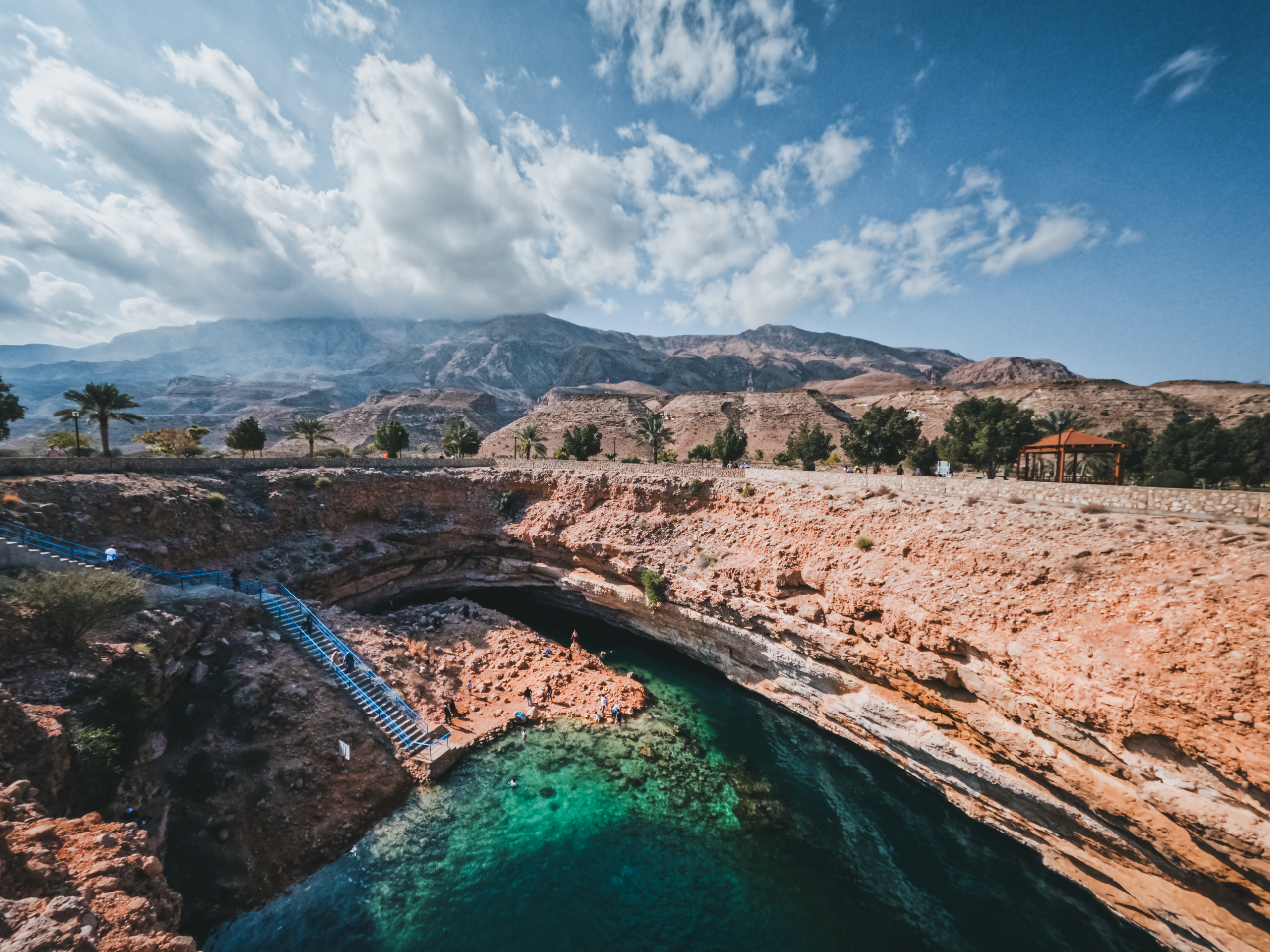
Why Bimmah Sinkhole is Oman’s Most Beautiful Natural Pool [Local Guide]
The Bimmah Sinkhole stands as one of nature’s most spectacular swimming pools in Oman. This natural wonder spans 50 meters by 70 meters and reaches depths of 20 meters. Deep turquoise waters contrast beautifully with golden cliff walls at this marvel, which sits just 600 meters from the sea between the coastal towns of Ḑibāb and Bamah.
Geologists attribute the sinkhole’s formation to limestone dissolution, but local folklore tells a more enchanting story. The locals believe a falling star created this magnificent pool, which explains its Arabic name “Hawiyyat Najm.” This natural wonder lies just 135 kilometers from Central Muscat and comes with modern facilities. Swimmers can enjoy a unique experience here as tiny fish provide natural pedicures.
Let us share everything you need to know about this remarkable natural pool in this piece. You’ll learn about the best photography spots and cultural etiquette that will help you plan a memorable visit to one of Oman’s most beautiful natural treasures.
The Natural Wonder of Bimmah Sinkhole
Oman’s rugged landscape hides an amazing natural masterpiece – the Bimmah Sinkhole. This natural wonder shows how geological processes have shaped our planet across thousands of years.
How the sinkhole formed
The story of Bimmah Sinkhole’s creation reveals the sort of thing I love about karst topography. Rainwater slowly worked its way through limestone bedrock for thousands of years. It dissolved the soluble rock and created underground cavities. The ceiling of one cavity eventually gave way, which created the dramatic bowl-shaped depression we see today.
The sinkhole’s formation got a boost from tectonic activity. Oman sits where the Arabian and Eurasian plates meet. These movements created weak spots in Earth’s crust that made it easier for water to erode the limestone below.
Local legends and stories
Bimmah Sinkhole’s cultural importance runs deep in local folklore. People call it “Hawiyat Najm” in Arabic, meaning “The Falling Star.” Locals believe a meteorite crashed from the sky to create this magnificent depression. Science might explain its origins differently, but these stories add a magical quality to the site.
The sinkhole’s waters hold a special place in local tradition. Stories passed down through generations speak of its healing powers, though scientists haven’t found evidence to back these claims.
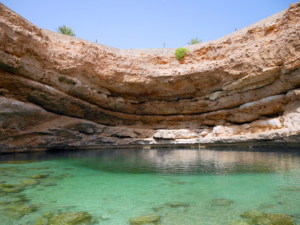
Unique geological features
This geological marvel stands out with its distinctive features. The sinkhole spans 50 meters by 70 meters and reaches about 20 meters deep. Its most eye-catching feature is the turquoise water filling the cavity. This beautiful color comes from sunlight interacting with mineral-rich water against limestone walls.
The Arabian Sea lies just 600 meters away and connects to the sinkhole through underground channels. This creates a mix of fresh and saltwater in the pool. Such a combination affects the water’s mineral content, making it rich in magnesium and calcium.
You’ll find other signs of karst landscapes in the surrounding area, like underground streams and caves. The rocks’ limestone and dolomite makeup tells us about ancient marine environments that once thrived here.
The sinkhole’s true depth remains a bit of a mystery. Some sources say it goes deeper than 300 feet in places. Others suggest the presence of underwater cave passages formed during the last ice age when sea levels dropped much lower.
The water changes as you go deeper. The surface stays crystal clear, but around 8 meters down, sulfur-oxidizing bacteria give the water a sulfuric taste. This adds another fascinating layer to this natural wonder.
Planning Your Visit
The right timing can transform your experience at Bimmah Sinkhole. Temperatures stay mild from October through April, ranging between 20°C to 30°C (68°F to 86°F). Weekday mornings or late afternoons give you the most peaceful experience, with fewer crowds than weekends.
Best times to visit
Photographers and solitude seekers should arrive at 8:00 AM when the park opens. This gives you about 40 minutes of quiet exploration before other visitors show up. Summer months (May-September) bring temperatures above 40°C (104°F), so early morning or evening visits are vital.
Getting there from Muscat
Bimmah Sinkhole sits about 130 kilometers southeast of Muscat, and finding it is simple. Take Route 17 (Muscat-Sur Highway), and you’ll see clear signs pointing to Hawiyat Najm Park after Dibab village. A car ride takes around 1.5 hours.
Visitors have several transport options:
- A rental car gives the most freedom
- Taxis run direct but cost more
- Some bus services operate on this route
Entrance fees and facilities
The park setting is well-kept with a small entrance fee. Gates open daily from 8:00 AM to 8:00 PM, staying open until 9:00 PM on Fridays.
You’ll find these amenities:
- Clean restrooms with Western and squat-style options
- Shaded spots for picnics and viewing
- Free parking area
- Swimmer’s changing rooms
What to bring
The right gear will give a comfortable visit. Here’s what you need:
- Swimming basics:
-
- Modest swimwear (women should opt for one-piece suits)
-
- Water shoes to protect feet
-
- Towels and spare clothes
Sun protection is vital since shade near the water is limited. Pack sunscreen, wide-brimmed hats, and sunglasses. Food vendors are rare in the area, so bring water and snacks.
Sturdy shoes help you walk safely on uneven ground around the park. Camera lovers should bring waterproof cases to capture underwater shots. Your own toilet paper might come in handy as supplies vary in the facilities.
Swimming in the Sinkhole
Swimming in Bimmah Sinkhole’s crystal-clear waters is a unique experience you won’t find anywhere else in Oman. The turquoise waters stay warm all year, making it perfect for a quick dip or a long swim.
Water depth and safety
The sinkhole’s depth changes quite a bit throughout. You’ll find shallow spots near the entrance that get deeper as you move toward the center. The main pool goes down 20-30 meters, and some parts might reach 90 meters deep.
You’ll have to watch out for yourself since there aren’t any lifeguards around. The concrete steps that lead to the water can be tricky because they’re uneven. Here’s what you should do to stay safe:
- Put on water shoes or old trainers so you don’t slip
- Stick to the edges if you’re not great at swimming
- Skip loose clothes – you won’t get them back if they fall into the deep parts
- Keep an eye on kids and think about life jackets for the little ones
The water stays surprisingly warm most of the year. First-time visitors should be careful since the pool gets deep faster than you might expect.
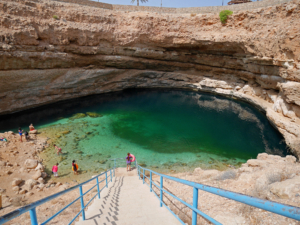
Fish species and interactions
The sinkhole’s fish make it special. You’ll find Garra Rufa fish, similar to the ones used in spa treatments, swimming around. These friendly little fish give you a natural pedicure, especially in the shallow parts.
The fish you’ll see change depending on where you are:
- Tiny fish just a few centimeters long swim in the shallow parts
- Bigger fish like tilapia sometimes show up behind the stairs
- The main swimming area has fewer fish, so it feels more like a regular swim
If you want to avoid the fish, head to the middle or far edges. But if you stand still in shallow water, these curious creatures will gather around you quickly. Their nibbling won’t hurt – it just tickles a bit.
The left side of the pool is amazing. The water turns baby blue under the overhanging cliff. This spot feels like a cave and adds something special to your swim.
The pool has an interesting mix of fresh and salt water that connects to the nearby sea. Around 8 meters down, the water starts to taste like sulfur because of certain bacteria, but surface swimmers usually don’t notice it.
The pool has no currents, which makes it great for a relaxed swim. Just remember that the depth changes quickly from shore to center, so stay alert. The water is so clear near the surface that you can see the sinkhole’s amazing structure while keeping a safe distance from the deeper parts.
Photography Guide
Beautiful photos of Bimmah Sinkhole need careful planning and the right photography techniques. The natural wonder gives you endless chances to capture stunning images, from dramatic reflections to underwater shots.
Best photo spots
You’ll find the most captivating shots at several key spots around the sinkhole. The low wall around the pool is a great spot to take those Instagram-worthy photos. Photos with people look better from the bottom of the sinkhole rather than from above.
The still water creates amazing reflections on calm days that make the rock walls seem endless beneath the surface. The left side of the pool is a chance to capture an enchanting baby blue shade under an overhanging cliff with its cave-like feel.
Lighting tips
Bimmah Sinkhole photos look best in early morning light. The park opens at 8 AM, which gives you about 30-40 minutes of quiet shooting time before other visitors show up.
The sinkhole’s famous turquoise waters shine differently in various conditions:
- Turquoise hues are most vibrant in mid-day sun
- Overall landscape shots benefit from soft early morning light
- Perfect reflections appear on the water when there’s no wind
Portrait shots should avoid harsh midday sun. Your subjects will look better in shaded areas where lighting is even. Reflectors can help soften harsh shadows from direct sunlight.
Camera settings
Underwater photography needs specific gear and settings to improve image quality:
- Essential gear:
-
- Waterproof camera or GoPro for underwater shots
-
- Wide-angle lens to fit the entire sinkhole
-
- Polarizing filter that cuts glare on water surface
Natural light works best for underwater scenes in shallow areas, usually above 5 meters depth. Deeper sections might need artificial lighting such as:
- Single strobe that creates dramatic shadow effects
- Double strobes to light up underwater subjects fully
- Video lights to preview illumination before shooting
Note that you should ask permission before taking photos of other visitors, especially locals. Keep your distance from swimmers and let others enjoy this natural wonder.
The surrounding park area has several high points to show the sinkhole’s impressive scale against the desert backdrop. Each time of day brings unique lighting conditions that create different moods and atmospheres in your photographs.
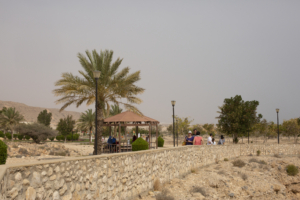
Cultural Etiquette and Local Tips
Your visit to Bimmah Sinkhole becomes richer when you respect local customs. The natural beauty of this place naturally blends with traditional Omani values. You will have a memorable experience by understanding and honoring these local traditions.
Dress code guidelines
The park has strict dress codes that guards enforce. Both men and women must cover their shoulders and knees. Swimming comes with its own set of rules:
Women should wear:
- Full-coverage swimwear or leggings with t-shirts
- Knee-length shorts with modest tops
- Extra clothes over swimsuits work well on weekends
Men typically wear:
- Traditional swim shorts
- Many men swim with their shirts on
Weekdays give you more flexibility with swimwear choices, but modesty remains important. The guards won’t let you enter if you wear crop tops, short shorts, or thong bikinis. A t-shirt over your swimwear is a good way to show respect for local customs.
Interacting with locals
Bimmah Sinkhole showcases true Omani hospitality. You’ll see local residents in their traditional white robes called dishdashas, and they’re remarkably friendly to visitors. This warm welcome shows the unique cultural values that set Oman apart from neighboring countries.
Omanis value the sinkhole deeply. Local families make it part of their weekend traditions and see it as a symbol of their natural heritage. Their pride shows in how they work to keep the site pristine.
The sinkhole fits naturally into Oman’s cultural scene. Instead of making it commercial, authorities keep its natural charm while making it easy to visit. This shows how Omanis balance development with preserving natural wonders for future generations.
You can feel safe about your belongings here. Theft rarely happens in Oman. Still, taking simple precautions shows you respect this trust-based culture.
Local folklore, especially the falling star legend, creates chances for great conversations with residents. These stories help you learn about how Omanis view nature’s connection to cosmic elements. When you show interest in these stories respectfully, you build bridges between cultures.
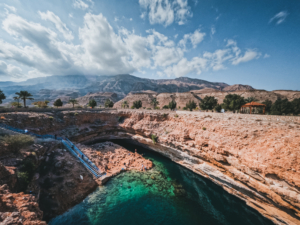
Conclusion
Bimmah Sinkhole ranks among Oman’s most striking natural wonders, where geological marvels meet cultural heritage. Our visit revealed this natural pool goes beyond its stunning turquoise waters and opens a window into Omani heritage and hospitality.
Scientists attribute its formation to limestone dissolution, yet local stories about falling stars add an enchanting dimension to this fascinating site. Modern facilities and easy access make this destination perfect for travelers who want natural beauty with comfort.
The timing of your visit will substantially impact your experience. Photographers will get the best lighting conditions early in the morning, and weekday visits offer peaceful swimming opportunities. Your respect for local culture and customs will create meaningful connections with the place and its people.
This spectacular pool sits perfectly between desert and sea, showing why Oman continues to fascinate adventure seekers and nature lovers. Swimming in its crystal-clear waters or photographing its beauty, Bimmah Sinkhole creates lasting memories for those who welcome its distinctive charm. Experience the charm, history, and beauty of Oman. Book your spot now!
